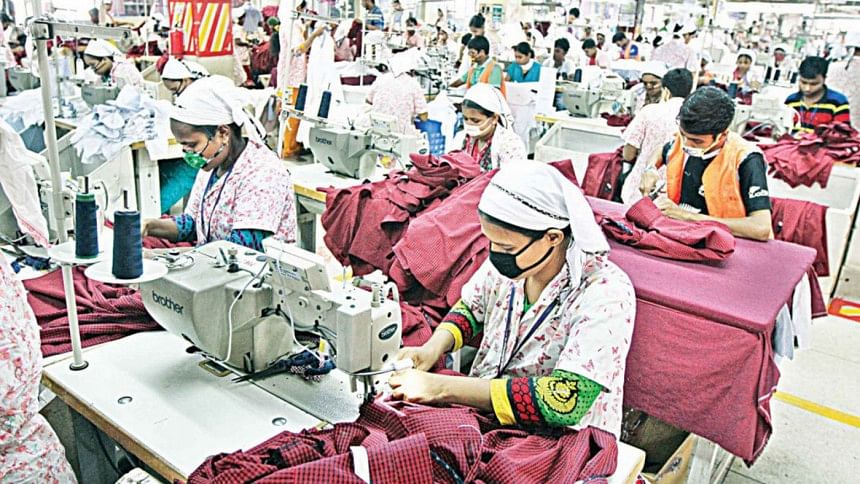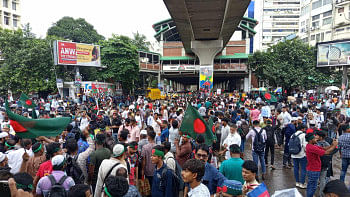Market diversification key to RMG growth

The year 2021 is a significant one for Bangladesh as the country is celebrating its 50th year of independence.
Our achievement as a nation in these years is remarkable and noteworthy. Bangladesh's extraordinary development surprised the world.
Our advancements in socio-economic development, human development indicators (HDI), and Millennium Development Goals (MDGs) have been widely praised across the globe.
Despite all the challenges and limitations, we were able to consistently maintain a GDP growth of more than 8 per cent in the last few years, before Covid-19 hit the world.
Although Covid-19's impact on the economy and growth is unavoidable, Bangladesh is doing better than any other Asian nation as far as the World Bank's economic growth projection is concerned. However, as laid out in the eighth Five-Year Plan, since the growth in the upcoming days will be driven by the industrial sector, there is no alternative but to focus on "Investment" and "Employment" in order to achieve the GDP growth target of 8.51 per cent.
In its 40-year journey, the garments industry has consistently played a significant role in the country's economic development through its contribution to foreign currency earnings, job creation, women empowerment and poverty alleviation, which is driving Bangladesh toward a prosperous nation.
The sector generates employment for four million people, around 60 per cent of whom are women.
But the upsetting factor is that even though we are the second largest garments exporter in the world right now, our export basket has always been concentrated and unexplored in terms of product, fiber, and market destination.
About 73 per cent of our total exports are concentrated on five basic items. The price of 80 per cent of these exports are as high as $15 per kilogramme. Around 74.14 per cent of our exports are concentrated on cotton while 80.67 per cent of these shipments go to markets in the EU and North America.
After the Multi Fibre Arrangement quota phase out, our manufacturers mostly focused on a volume driven growth strategy and as a result, the export basket has been limited to basic items.
Although we have advanced a lot in safety and sustainability, Bangladesh's garment industry lacks diversification. To be competitive in the race of this fast fashion arena, we need to flag out market and product diversification as an immediate need.
At this stage, while celebrating our impending graduation from the UN's list of least developed countries (LDCs) thanks to hard work and dedication, our strategic priority should concentrate on sustaining this growth momentum powered by innovation and diversification.
Especially with Covid-19 exposing the vulnerabilities of over dependence has made the issue of market diversification more crucial than ever.
Up till now, diversification in export items and export destinations has always been very narrow in case of the local garments industry. Over the last few years, Bangladesh's apparel has started to become more diversified and tremendous progress has been achieved in terms of new market exploration.
The percentage of Bangladesh's apparel exports to non-traditional markets during fiscal 2008-09 was only 6.87 per cent while it reached 16.16 per cent in fiscal 2020-21, when the country's export revenue hit $5.08 billion. Such growth in non-traditional markets was possible thanks to various policy support and initiatives taken by the government and private industry.
The Bangladesh Garment Manufacturers and Exporters Association (BGMEA) initiated several scoping missions to Brazil, Mexico and Chile to enter Latin American countries.
There were no Bangladesh embassies in any of these countries before 2011, nor were there any embassies of Latin American countries in Bangladesh at the time either.
The BGMEA organized several trade missions to Latin America in 2010 and 2011, and submitted reports to the government, requesting it open missions there.
The government then opened an embassy in Brazil, which also opened its own embassy in Dhaka.
So, the visa process and travel to the region has become easier.
The BGMEA also organized trade missions to China, Japan and Russia. We have to re-launch those initiatives to keep the momentum of our export to new markets.
Major markets such as Australia, Japan, Norway, New Zealand, Switzerland, South Korea, Russia, India and even middle-eastern countries like the UAE, Qatar, Kuwait, Kingdom of Saudi Arabia and Bahrain should also be considered as they are among the markets with high potential that remain largely untapped.
We need to organize more promotional campaigns and road-shows to introduce "made in Bangladesh" products across the globe, as well as draw more foreign investment for our textiles and high-end fashion industry.
And throughout the journey of diversification, commercial diplomacy will be vital for us to explore new markets since tariff is a major barrier that remains in almost all potential markets.
Besides, we need to keep in mind that there are potentials to further penetrate existing markets in the EU and US.
A thorough market research to explore product and sourcing mix of the brands who are currently sourcing from Bangladesh, as well as those who are sourcing on limited scale will be helpful in this regard.
There are also a huge number of brands in the EU and US that are still not sourcing from Bangladesh due to the product categories or volume they require that can also be tapped for huge additional growth in those markets.
Since Bangladesh has graduated to a middle-income country, there will be inevitable changes in market access. While using the special dispensation of LDCs for the few remaining years, we must not lose sight of a long-term strategy of deepening the country's competitiveness as it prepares to graduate from LDC status.
We need to prepare a comprehensive National Export Strategy and align our trade policies accordingly to promote investments. In business and trade, backward and forward linkages play a vital role.
A tactical investment campaign is needed to develop the capacity of these industry linkages, keeping in mind the requirement of double transformation in line with the Global Value Chain (GVC).
At the same time, we should also prepare to follow the new global trend and continue seeking market access under the various bilateral and regional trade, and investment arrangements.
Bangladesh is yet to have a fully operational bilateral free trade agreement (FTA) despite having signed a few preferential trade agreements and regional agreements like SAFTA, APTA, BIMSTEC and TPS-OIC.
The government has received proposals for potential bilateral trade agreements from several countries including China, Malaysia, Singapore and Thailand in recent years.
Besides, the government is also working on free trade and economic partnership agreements with countries like India, Sri Lanka, Indonesia, and so on.
In terms of increasing the share of our garment exports to these regions and building cooperation in technological transfer as well as attracting more Foreign Direct Investment (FDI), these regions can be a great hub for Bangladesh.
Bangladesh is now passing through a golden age in terms of population dividend. About 65 per cent of our people are within 18 to 40 years of age.
We have an active population of around six million people in Bangladesh and every year around 2 million more join the labor force.
A country usually does not possess such a young and vibrant population even in a century. We have to prioritize strategy for harnessing benefits from this young workforce by making them upskilled and tech-savvy with proper technical and market driven education programs.
The country's prosperity and economic growth has evolved through the contribution of manufacturing sectors, especially garments.
The stability of Bangladesh's economy is largely dependent on the apparel industry and to secure this sector, we need a planned strategy for future investment.
The BGMEA is continuously working on areas regarding market access, backward linkage industries, and suggested the government should develop a virtual marketplace for local garment products.
The government's policy support in areas such as education and financial policies, free trade and regional trade agreements, and existing trade barriers such tariff and non-tariff barriers related to the garment industry is vital and crucial.
Only with these supports will we be able to upgrade the sector which has been acting as the pillar of Bangladesh's economy for a long time.
The author is president of Bangladesh Garment Manufacturers and Exporters Association (BGMEA).

 For all latest news, follow The Daily Star's Google News channel.
For all latest news, follow The Daily Star's Google News channel. 



Comments